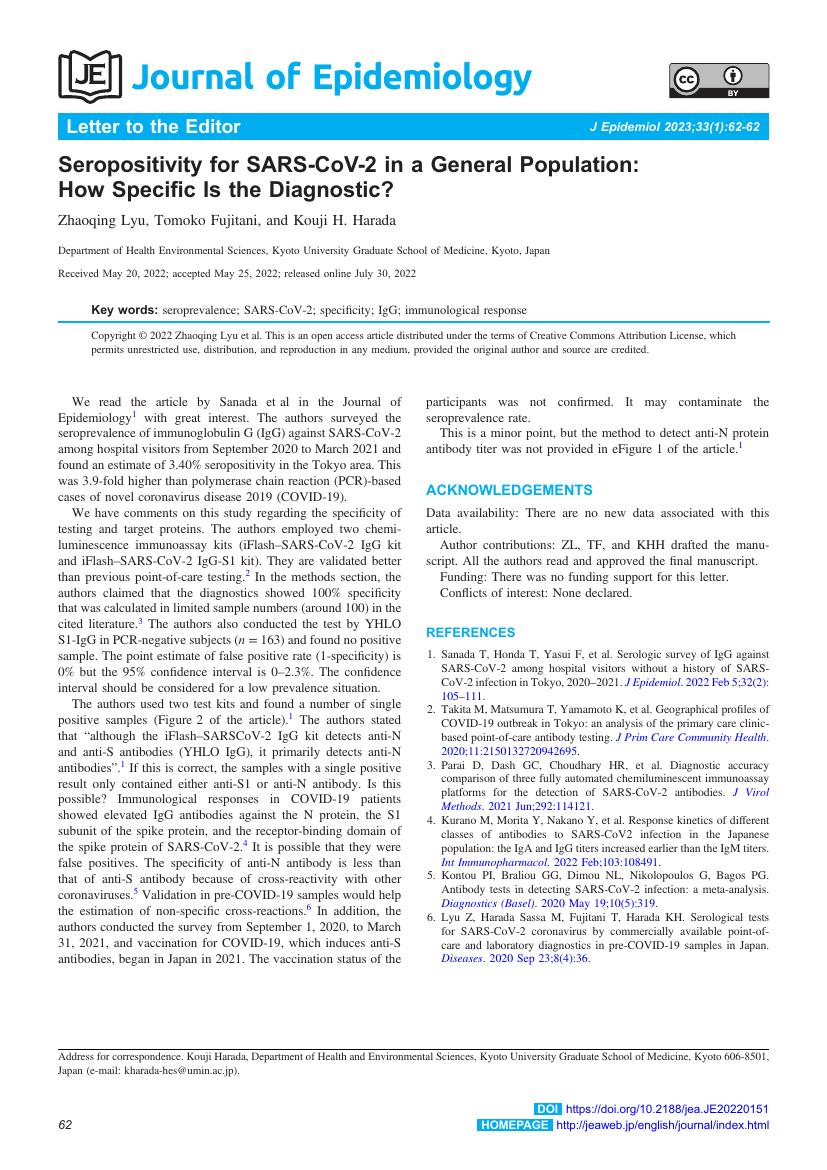- 著者
- Sani Rachman Soleman Zhaoqing Lyu Takuya Okada Mariko Harada Sassa Yukiko Fujii Manal A.M. Mahmoud Daniel K Ebner Kouji H. Harada
- 出版者
- The Japanese Society for Hygiene
- 雑誌
- Environmental Health and Preventive Medicine (ISSN:1342078X)
- 巻号頁・発行日
- vol.28, pp.1, 2023 (Released:2023-01-07)
- 参考文献数
- 75
- 被引用文献数
- 3
Background: Healthcare workers (HCWs) employed personal protective equipment (PPE) during the COVID-19 pandemic, crucial to protecting themselves from infection. To highlight the efficacy of PPE in preventing environmental infection among HCWs, a systematic review was conducted in line with PRISMA guidance.Methods: A search of the PubMed and Web of Science databases was conducted from January 2019 to April 2021 using pre-defined search terms. Articles were screened by three researchers. The approved papers were read in full and included in this review if relevance was mutually agreed upon. Data were extracted by study design and types of PPEs.Results: 47 of 108 identified studies met the inclusion criteria, with seven reviews and meta-analyses, seven cohort, nine case-control, fifteen cross-sectional studies, four before and after, four case series, and one modeling studies. Wearing PPE offered COVID-19 protection in HCWs but required adequate training. Wearing surgical masks provided improved protection over cloth masks, while the benefit of powered air-purifying respirators is less clear, as are individual gowns, gloves, and/or face shields.Conclusions: Wearing PPE, especially facial masks, is necessary among HCWs, while training in proper use of PPE is also important to prevent COVID-19 infection.
- 著者
- Zhaoqing Lyu Tomoko Fujitani Kouji H. Harada
- 出版者
- Japan Epidemiological Association
- 雑誌
- Journal of Epidemiology (ISSN:09175040)
- 巻号頁・発行日
- vol.33, no.1, pp.62, 2023-01-05 (Released:2023-01-05)
- 参考文献数
- 6
- 著者
- Zhaoqing Lyu Tomoko Fujitani Kouji H. Harada
- 出版者
- Japan Epidemiological Association
- 雑誌
- Journal of Epidemiology (ISSN:09175040)
- 巻号頁・発行日
- pp.JE20220151, (Released:2022-07-30)
- 参考文献数
- 6
- 著者
- Shanika Nanayakkara STMLD Senevirathna Tilak Abeysekera Rohana Chandrajith Neelakanthi Ratnatunga EDL Gunarathne Junxia Yan Toshiaki Hitomi Eri Muso Toshiyuki Komiya Kouji H. Harada Wanyang Liu Hatasu Kobayashi Hiroko Okuda Hideyuki Sawatari Fumihiko Matsuda Ryo Yamada Takao Watanabe Hideki Miyataka Seiichiro Himeno Akio Koizumi
- 出版者
- Japan Society for Occupational Health
- 雑誌
- Journal of Occupational Health (ISSN:13419145)
- 巻号頁・発行日
- pp.13-0172-OA, (Released:2013-12-18)
- 被引用文献数
- 91
Objectives: Previous investigations on chronic kidney disease of unknown etiology characterized by tubulointerstitial damages (CKDu) in the North Central Region (NCR) of Sri Lanka have supported the involvement of social, environmental and genetic factors in its pathogenesis. Methods: We conducted a social-environmental-and-genetic epidemiology study on a male population in NCR to investigate the genetic and environmental contributors. We recruited 311 case-series patients and 504 control candidates. Of the 504 control candidates, 218 (43%) were eliminated because of the presence of hypertension, proteinuria, high HBA1c, high serum creatinine or high alpha-1 microglobulin in urine. Results and Discussion: None of 18 metals measured (µg/l) in urine, including Cd, As and Pb, showed significantly higher concentrations in cases compared with controls. As speciation results showed that 75-80% of total urinary As was in the form of arsenobetaine, which is non-toxic to humans. None of the metal concentrations in drinking water samples exceeded guideline values. A genome-wide association study (GWAS) was conducted to determine the genetic contributors. The GWAS yielded a genome-wide significant association with CKDu for a single nucleotide polymorphism (SNP; rs6066043; P=5.23×10-9 in quantitative trait locus analysis; P=3.73×10-8 in dichotomous analysis) in SLC13A3 (sodium-dependent dicarboxylate transporter member 3). The population attributable fraction and odds ratio for this SNP were 50% and 2.13. Genetic susceptibility was identified as the major risk factor for CKDu. However, 43% of the apparently healthy male population suffers from non-communicable diseases, suggesting their possible influence on CKDu progression.

